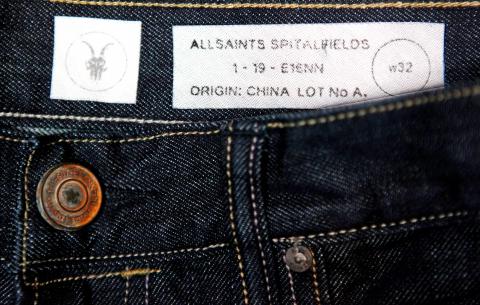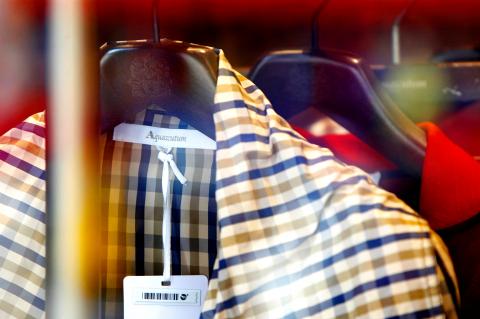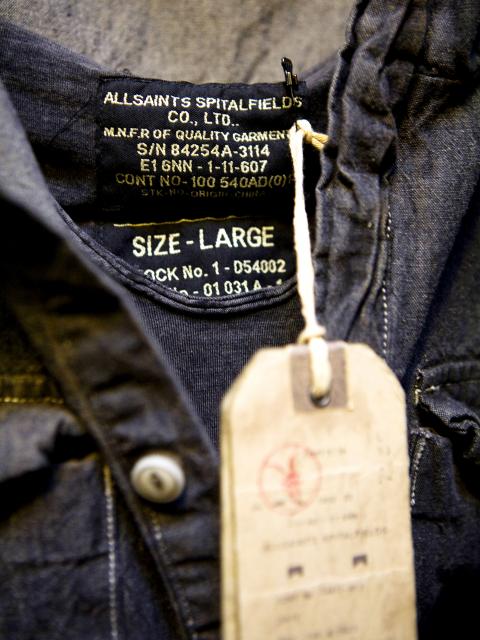Leah Missbach Day, 52, a photojournalist in Chicago, likes designer labels like Balenciaga, Alexander Wang and Dries Van Noten. But not next to her skin. “I cut them out because they’re scratchy and they bug me,” she said. “I’ve got a whole drawer full of tags.”
Though clothing designers and manufacturers may sweat the graphics and placement of their signature labels, many of their customers, armed with tiny sewing scissors and seam rippers, toil just as avidly to remove them. On the Web, several sites demonstrate how it’s done without leaving telltale holes.
But lately there’s been a trend toward subtlety and comfort in clothing labels. Big tags with blaring logos sewn inside garments are seen by many as passe (and forget about crocodiles and polo ponies stitched on the outside). More designers are downplaying or even disguising their labels, which can lend cachet, like a club with an unmarked door.

photo: BLOOMBERG
So-called “tagless” labels, printed directly onto clothes, are also more widely used, as are transparent plastic labels that are almost invisible. The result is a change in the way clothes look and feel.
Some people, like Day, find labels uncomfortable, while others object to having another person’s name or corporate logo on their clothes. Still others think tags detract from the attractiveness of garments, particularly when they show through something sheer or flip up so they are visible above a collar or waistband. (All the more distressing when strangers, or your mother-in-law, tuck them back in for you.)
TAG OUT

photo: BLOOMBERG
Susan Fisher, 56, of New York, who wears designer clothes by Donna Karan, Carolina Herrera and Jil Sander, uses nail scissors to snip the stitching around labels and tweezers to pull out the threads. “Why leave them in there when they’re only going to annoy you?” she said. “The washing instructions are meaningless to me because I err on the side of caution and dry clean everything, and I don’t really care who made it as long as it looks good on me.”
Those who are sensitive about their size may also be quick to cut out labels. Rozlind Power, 27, an events planner in Houston who used to sell clothes in a high-end boutique, said it’s common for people to remove labels if the size is bigger than their self-image. “It’s understandable when sizes vary so much,” Power said. “I wear an XS at Banana Republic but have a bridesmaid’s dress by Betsey Johnson that is size 10, which I would probably cut out if I had to look at it all the time.”
Zak Graff, 34, a marketing consultant in Los Angeles, said he likes the cut and fit of the Spanish brand Zara, but “the labels drive me crazy because they are 2 to 3 inches long and stacked one on top of another.” (Any clothing sold in the EU must have attached labels translated into every member country’s language.)

photo: BLOOMBERG
Graff keeps a seam ripper in his dopp kit to remove such aesthetic and potentially allergenic offenses. “I take out the labels when I cut off the hanging price tag,” he said. “It’s this whole process after I buy something new.”
But before he can remove a label, he has to actually see it. Some brands, like the French active-wear line Aigle, as well as Elie Tahari and Josie Natori have within the last three years begun using clear labels. Made of flexible plastic, these are usually in the side seam.
“It’s very much about comfort,” said Ilse Metchek, president of the California Fashion Association, which represents the state’s apparel manufacturers. “But it’s also a reflection of fabric being expensive and plastic being cheap, and there’s no sewing edges of the plastic label. Just a laser cut. Easy.”
NEW LABELS
Tagless labels, which first appeared a decade ago but have become more prevalent within the last two to three years, involve either stamping or ironing text onto the garment. “People really have issues with labels,” said Rick Elmore, vice president for product development at Hanesbrands, one of the first companies to feature tagless labels. “We were hearing it again and again.”
Athletic-wear brands including Nike, Adidas, Reebok and Puma soon followed, and now tagless labels can be found on garments made by many top brands including Banana Republic, J.Crew, Gap, Ann Taylor and H&M.
While there were early complaints that the ink used in tagless labels flaked and became prickly after several washings, the technology has improved. “The digital presses are more precise so we use less ink and it settles into the garment, so it doesn’t look as plasticky and it’s softer,” said Shawn Neville, vice president for retail branding at Avery Dennison Corp, which develops and makes labels. “That’s why you see more well-known brands going tagless these days.”
SECRET LOVE
But tagless labels can fade over time, according to Scott Schuman, who writes the Sartorialist fashion blog. “And then you end up putting on your T-shirt backwards, which is a total pain,” he said. He believes labels are an important design feature that denote quality and even add value like an artist’s signature on a print. Indeed, vintage clothes with intact labels sell for higher prices than those without. “We all like to complain about labels but we secretly love them,” Schuman said.
Nontraditional designer labels can be a mark of distinction. Consider Martin Margiela’s blank white label, Stella McCartney’s delicate metal chain, Peggy Jennings’ bit of lace and Rick Owens’ two slim, parallel gray ribbons.
Ken Downing, fashion director at Neiman Marcus, said, “With many designers less intrigued with the idea of logos, the artistic tag begins a new conversation with the consumer,” serving as an “insiders’ inside message.”
Owens described his label as an artisanal gesture. “It was always important to me that there be a personal, intimate connection between what I did and whoever responded to it,” he said.
And even Graff in Los Angeles leaves the iconic plaid tag in his Burberry suit because he thinks it’s a “unique design element.”
Marcia Sherrill, 50, a handbag designer in New York, said she has a “moment of bonding” looking at the designer labels in her clothes before getting dressed. “To see the Givenchy and Yves Saint Laurent brands is a reminder that this little girl from Alabama made good,” she said.
That doesn’t stop her, though, from putting a Band-Aid over them to keep them from scratching.

In the March 9 edition of the Taipei Times a piece by Ninon Godefroy ran with the headine “The quiet, gentle rhythm of Taiwan.” It started with the line “Taiwan is a small, humble place. There is no Eiffel Tower, no pyramids — no singular attraction that draws the world’s attention.” I laughed out loud at that. This was out of no disrespect for the author or the piece, which made some interesting analogies and good points about how both Din Tai Fung’s and Taiwan Semiconductor Manufacturing Co’s (TSMC, 台積電) meticulous attention to detail and quality are not quite up to

April 21 to April 27 Hsieh Er’s (謝娥) political fortunes were rising fast after she got out of jail and joined the Chinese Nationalist Party (KMT) in December 1945. Not only did she hold key positions in various committees, she was elected the only woman on the Taipei City Council and headed to Nanjing in 1946 as the sole Taiwanese female representative to the National Constituent Assembly. With the support of first lady Soong May-ling (宋美齡), she started the Taipei Women’s Association and Taiwan Provincial Women’s Association, where she

It is one of the more remarkable facts of Taiwan history that it was never occupied or claimed by any of the numerous kingdoms of southern China — Han or otherwise — that lay just across the water from it. None of their brilliant ministers ever discovered that Taiwan was a “core interest” of the state whose annexation was “inevitable.” As Paul Kua notes in an excellent monograph laying out how the Portuguese gave Taiwan the name “Formosa,” the first Europeans to express an interest in occupying Taiwan were the Spanish. Tonio Andrade in his seminal work, How Taiwan Became Chinese,

Mongolian influencer Anudari Daarya looks effortlessly glamorous and carefree in her social media posts — but the classically trained pianist’s road to acceptance as a transgender artist has been anything but easy. She is one of a growing number of Mongolian LGBTQ youth challenging stereotypes and fighting for acceptance through media representation in the socially conservative country. LGBTQ Mongolians often hide their identities from their employers and colleagues for fear of discrimination, with a survey by the non-profit LGBT Centre Mongolia showing that only 20 percent of people felt comfortable coming out at work. Daarya, 25, said she has faced discrimination since she